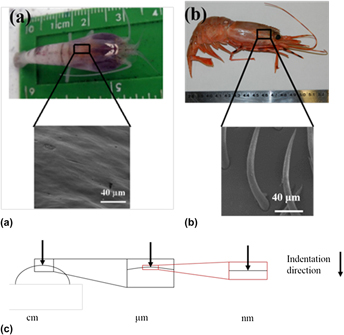Article contents
A comparison of nanoindentation creep deformation characteristics of hydrothermal vent shrimp (Rimicaris exoculata) and shallow water shrimp (Pandalus platyceros) exoskeletons
Published online by Cambridge University Press: 30 March 2015
Abstract

This investigation reports mechanical properties of the exoskeleton of deep sea shrimp, Rimicaris exoculata, at temperatures ranging from 25 to 80 °C measured using nanoindentation experiments. The measured properties are compared with the corresponding shallow water shrimp (Pandalus platyceros) exoskeleton properties. Scanning electron microscopy suggests that both types of shrimp exoskeletons have the twisted plywood, Bouligand structure. However, they differ in the volume fraction and distribution of mineral content. The variations in the nanoindentation measured hardness values of the examined shrimp exoskeletons are found to be strongly correlated with the corresponding compositional difference between the two exoskeleton types. Nanoindentation creep strain rate measurements are performed to provide an assessment of the two types of exoskeleton for the role of proteins and minerals to cause difference in behavior and properties between the two shrimp species. The measured creep load–depth data are fitted with a viscoelastic creep function to find the creep compliance as a function of experimentally varying temperature and in the context of natural variations in mineral content.
- Type
- Articles
- Information
- Copyright
- Copyright © Materials Research Society 2015
References
REFERENCES
- 13
- Cited by




